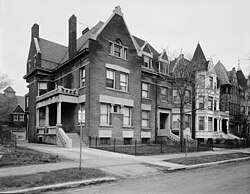Robert S. Abbott House | |
 Robert S. Abbott House | |
| Location | 4742 South Dr. Martin Luther King Jr. Drive, Chicago, IL |
|---|---|
| Coordinates | 41°48′28.9″N87°37′1.4″W / 41.808028°N 87.617056°W |
| Built | c. 1900 |
| Architectural style | Queen Anne |
| NRHP reference No. | 76000686 |
| Significant dates | |
| Added to NRHP | December 8, 1976 [1] |
| Designated NHL | December 08, 1976 [2] |
The Robert S. Abbott House is a historic house in the Grand Boulevard community area of Chicago, Illinois.
Contents
Built in 1900, it was the home of Robert S. Abbott, founder and publisher of the Chicago Defender , the most-circulated African-American newspaper in the nation, from 1926 up until his death in 1940. His home was designated a National Historic Landmark status in 1976. [2] [3] [4]



